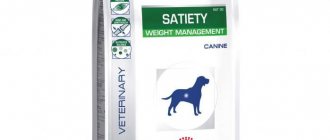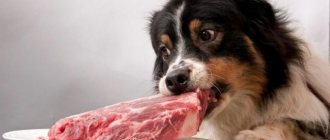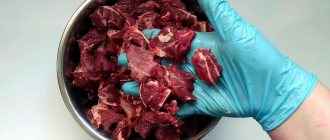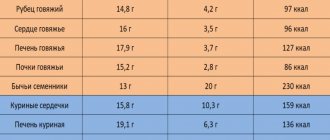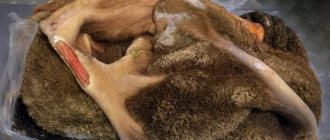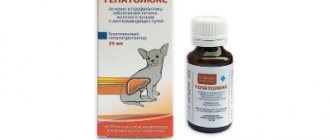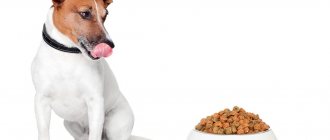By-products have certain benefits for the dog’s body. They are a source of vitamins A, B1, B2, B6, B12, D, E, K, protein, essential fatty acids, manganese, selenium, zinc, potassium, magnesium, copper, phosphorus, iron, iodine.
It is noteworthy that the organs of animals fed in natural conditions, on pastures, contain more useful substances.
It is especially useful to give offal to your dog in winter, since these products contain vitamin D, which is so necessary for living organisms.
Beneficial properties and possible harm
Giblets are classified as dietary products, since the content of fats and carbohydrates in them is very low. In addition to the fact that tripe is quite cheap, it contains many useful components:
- proteins;
- trace elements: P, Fe, Cu, Mg, I, K, Zn, Se;
- vitamins A, K, E, D and group B;
- folic acid;
- fatty acids: Omega-3, Omega-6.
It is better to take tripe from animals that were fed natural food.
We recommend this article:
Basics of healthy pet nutrition or what to feed your dog
Despite their usefulness, offal can be harmful to a dog’s health:
- Individual intolerance. Manifested by diarrhea and vomiting.
- If you feed your pet only liver, this can lead to the formation of stones in the organ of the same name. It should be no more than 5% of the diet.
- You shouldn't overfeed your dog's heart either. Heavy protein, which is poorly digested, often causes diarrhea.
Negative reactions
Giblets are not for everyone. Many people, especially those who were overfed in childhood, develop food allergies to one or another product. Most often, a negative reaction applies to only one element, and it is enough to identify it and eliminate it for the pet’s well-being to return to normal.
Allergies usually manifest themselves:
- Digestive problems, externally expressed by diarrhea.
- Vomiting.
- Skin irritation in sensitive areas: on the ears and face, in the armpits, on the front legs and around the anus.
- Scabies and red spots.
- Hair loss in certain areas.
- Infections that can be caused by improperly processed food.
How and what to feed your dog
Veterinarians recommend giving your animal giblets twice a week. However, daily feeding is also allowed if the portions are reduced. It is impossible to transfer your pet completely to tripe. It should make up only 10–15% of the total diet. Puppies begin to be accustomed to the udder and chicken necks from 2–3 months, and to other offal from 5–6 months.
We recommend this article:
What cereals can be given to dogs and what should not be fed?
Liver
The liver is rich in vitamins A, B, iron, folic acid. It is best to give it raw, since the cooking process reduces the amount of beneficial microelements. The benefits of the by-product are as follows:
- improving the functioning of the gastrointestinal tract;
- positive effect on the reproductive organs;
- strengthening the nervous and cardiovascular system;
- normalization of metabolism and brain function;
- increasing endurance.
In addition, iron contained in the liver is necessary for the formation of hemoglobin and saturation of cells with oxygen.
We recommend this article:
Why dogs can’t have sweets and is this really true?
Lung
An ambiguous by-product, since it does not bring any particular benefit to the animal. It contains virtually no protein and is also low in calories. Due to the large amount of connective tissue, the lungs are poorly digested. It is recommended to boil them well and chop them before use.
Heart
The organ is rich in antioxidants, beneficial microelements (Se, Zn, P), B vitamins, and amino acids. It also contains the immunomodulator coenzyme Q10, which slows down cell aging. The usefulness of the by-product is very high:
- building muscle mass;
- energy production and reserve;
- increasing endurance;
- positive effect on joints.
The structure of the heart is denser and heavier than that of meat, but it is possible to feed dogs the organ raw.
Kidneys
The fatty acids that buds contain have a beneficial effect on your pet's coat and skin. The organ is also rich in microelements (Zn, P), vitamins (A, B, E, K). If your dog has digestive problems, veterinarians recommend including this by-product in the diet, as it stabilizes the gastrointestinal tract.
It is not necessary to boil the kidneys. Before use, they are cut lengthwise and then soaked in cold water.
Udder
Beef udder, like lungs, consists of a large amount of connective tissue, but is absorbed much better. The organ is rich in vitamins, and therefore its introduction into the diet promotes the following processes:
- building muscle mass;
- increasing endurance;
- recommended for pregnant and lactating bitches.
The udder is given to dogs in small portions raw, after removing excess fat.
Brain
The by-product is indispensable if you need to bring an animal out of a state of exhaustion. The organ is well digestible, rich in choline and lipids. Raw beef brains are not given to dogs. Before eating, they are boiled with the addition of cereals (rice, buckwheat). Very useful for weakened pets, as well as for dogs during the mating period.
Spleen
The organ is rich in complete protein, iron, and amino acids. Its properties are similar to muscle meat or liver. The offal must be boiled before use. Small portions of spleen are introduced into the diet so that the animal does not develop intestinal upset. When a dog overeats, diarrhea begins and the color of the stool turns black.
Tripe, abomasum
By-products are distinguished by a large amount of protein, enzymes, amino acids, and beneficial microflora. They are very useful for the animal’s body:
- support the functioning of the gastrointestinal tract;
- normalize metabolism;
- neutralize and remove toxins from the blood;
- strengthen the immune system.
The cow's stomach is fed raw to the pet, having first been washed and cleared of its contents.
We recommend this article:
What You Need to Know About Selecting and Treating Tripe for Dogs
Ears, legs, tails
There is practically no protein in these by-products, but they are rich in calcium, phosphorus, amino acids, elastin, and collagen. The dog loves to chew ears, legs, tails, lips, both raw and boiled. This is a great workout for your jaws and also strengthens your teeth. It is necessary to cook the tripe for a long time (3–4 hours) until a strong broth is obtained.
Heads and cartilaginous by-products
Cartilage by-products include:
- trachea;
- diaphragm;
- kaltyk;
- epiglottic cartilages.
They have a lot of protein, collagen and elastin. When fresh, they are frozen for 3 days and doused with boiling water before use. The heads contain calcium. They are fed to the pet boiled, separated from the skin and bones.
Poultry by-products
Poultry offal is not as valuable as beef offal, but it can also be added to your pet's diet. Chicken heads contain a lot of calcium and are good for training the jaw muscles. Before feeding, they need to be broken, beaked and boiled.
We recommend this article:
The right diet or what vegetables can be given to dogs
Internal organs are rich in vitamins A, B12, protein, microelements (Zn, Fe). Bones, paws, and necks contain large amounts of calcium, phosphorus, as well as substances that are beneficial for dog joints.
We recommend this article:
How to calculate the daily calcium intake for puppies and adult dogs?
It is best to feed your pet bone mince, which you can prepare yourself or buy ready-made.
A strong broth is boiled from bird legs for 3–4 hours. The claws are removed, the skin is removed, and the meat is given to the pet in its pure form or mixed with porridge. Before feeding, the necks are also boiled or scalded with boiling water.
Making special treats at home
Heads, legs and necks of chicken or turkey are often used to make broth or jellied meat. The latter is best prepared from chicken or turkey legs. They are soaked in cool water and then boiled for about 2-3 hours over low heat, periodically removing the foam.
You should not add salt or spices to the dish. After cooking, the broth is filtered and poured into molds, which are placed in the refrigerator. Jellied meat is suitable as an addition to porridge or as a separate dish.
A dried delicacy is made from the udder, which they take with them on a trip, for a walk, or treat them to during training. The udder is washed and dried well. The next step will be freezing the raw materials. In this form, the udder is cut into small pieces and laid out on a baking sheet. Dry in the oven for 2-3 hours at a temperature not exceeding 80 degrees. Keep chips in a closed container in the refrigerator.
Porridge is made from the heart for puppies and adults. First, prepare the broth, then take out the cooked meat and chop it finely. Cereals, chopped vegetables, and herbs are added to the liquid. After preparing the cereal, the porridge is combined with pieces of tripe and cooled.
Selection and storage of offal
Dogs should not be fed spoiled offal. If the giblets have an uncharacteristic consistency, smell unpleasant and have an unhealthy color, it is better to throw them away. Some owners soak the tripe in water with the addition of baking soda, but it is better not to risk it.
Before giving raw giblets to your pet, they must undergo a veterinary inspection. If no research has been carried out, they need to be boiled or frozen. By-products obtained from sick animals can cause great harm to the health of your pet.
We recommend this article:
Healthy treats for dogs or how not to harm your pet
Industrial feed
In the composition of industrial dry food, the presence of by-products is often listed first. Before purchasing such a pack, you should know about some of the features of using this ingredient on an industrial scale.
Firstly, it should not come first, since tripe is not as nutritious as meat, which means the food will not have enough calories and will not be able to provide the necessary energy for an active life.
Secondly, dry food contains organs that are unsuitable for human food. That is, this is tripe that has not been frozen for more than a day since the carcasses were cut up. It is no longer suitable for people, but for dogs after appropriate processing, drying and grinding it will be completely healthy and will not cause any harm.
What are by-products: what parts of the carcass
When it comes to beef, by-products include:
- Pical meat is the glands: thymus, salivary glands, pancreas, tonsils, ovaries;
- Trimmings from heads, including the sublingual cut;
- Flank, hem;
- Internal organs: liver, heart, spleen, kidneys, lungs, tripe, mesh, book, rennet, brains;
- Udder, testes;
- Bones and cartilage: beef tails, lips and noses, bovine penis, ears, kaltyk (part of the trachea).
Tripe for dogs
Pieces of trachea
If we are talking about poultry (chicken, turkey), then in addition to hearts and liver, gizzards are highly valued. Dogs can also be given raw chicken heads (after removing the beak), chicken legs and necks.
Turkey necks
Dried
These are dried or dried products that have retained all the beneficial substances and have natural flavors and aromas. Compared to raw or cooked options, dried foods have many advantages:
- subject to all preparation conditions, they are safe and healthy;
- convenient to store;
- can be transported and taken on the road;
- used for treats or rewards in training.
Pet stores and online stores mainly sell dried varieties of bovine by-products.
Cooking at home
It is quite difficult to do this at home. If you make the slightest mistake, the product can be spoiled, which increases the risk of poisoning your pet. But some owners still experiment and dry fibers that are not too dense, such as chicken offal, in ovens.
Benefit for health
Many people simply adore beef liver, but they treat kidneys with disdain, but in vain. Although this is a little specific, it is a very useful product. The benefits of beef kidneys for humans lie primarily in the content of vitamins B, PP, A, C and E, as well as a large amount of iodine, phosphorus, calcium, sodium, potassium and iron. As you know, selenium has the ability to have a beneficial effect on the functioning of the thyroid gland, which is responsible for the production of hormones that are very important for human health: thyrocalcitonin, thyroxine and triiodothyronine. These substances are involved in numerous metabolic processes in the human body. In addition, it has been proven that selenium prevents the formation and development of bad cells, in particular cancer cells.
Chicken stomachs
Should you feed your dog chicken gizzards? You can, as they are another inexpensive addition to complete nutrition.
- The advantage of this by-product is its low calorie content - 150 kcal per 100 g, so it may well be a dietary food for overweight dogs.
- Its advantages do not end there; the content of vitamins and minerals is very important for the normal development of the pet.
You can give it as a separate dish twice a week, or as part of your daily diet, but in much smaller quantities.
In order not to infect your pet with parasites, it is better to boil the stomachs for 5-15 minutes. Buy already peeled and check for freshness.
You can give both chicken tails and paws freed from claws. For complete nutrition, meat and offal should be given along with rice or buckwheat porridge, seasoned with vegetables.
Chicken liver
Is it possible to give a dog chicken liver? Of course, it is possible and necessary, because this product is rich not only in vitamins A, B, E, D, but also in minerals, mainly iron. It also contains amino acids that are necessary for any living organism. The liver increases hemoglobin in the blood. Give no more than twice a week, because too much iron will not be beneficial.
When buying a liver, you need to pay attention to its appearance. It should be a bright, uniform brown color, with clear contours, and not leave dents when pressed. Unlike other offal, it should be boiled, as it can be a source of helminths.
How long to cook beef kidneys until ready for dogs
The majority of a dog's diet consists of meat and meat by-products. Among the latter are chicken offal, liver, heart, pork trimmings, and testes. At first glance, such food is disgusting - it looks unpleasant and emits a specific smell. But in fact, it is an irreplaceable source of proteins, has great nutritional value and an attractive taste for dogs.
Feeding your pet
Advantages of the purchased product
Cooking beef lung is a very troublesome and time-consuming task. But if you don’t have the opportunity to mess around in the kitchen, then you can buy dried lung, specially prepared for dogs. This food has many advantages. It is prepared under industrial conditions from parts of the carcass that have undergone intensive veterinary testing.
For preparation, a special dryer and special drying modes are used to preserve the maximum amount of useful substances.
The structure of the feed is light and porous. It is perfect for oral care, satisfies the dog’s natural need to chew something, strengthens the jaws, prevents the formation of tartar, and protects against gum disease and periodontitis.
Suitable for all dogs: young, elderly, puppies, overweight.
How important are beef kidneys in a dog's diet? Detailed analysis of the product
Sooner or later, a dog breeder faces the question of whether to feed the dog by-products or only pure meat? Beef kidneys are cheaper than pulp, and is there any point in giving them, even if the budget allows you to feed your pet clean tenderloin?
The answer is clear: yes. Beef kidneys are beneficial for the animal's body. Eating the entire carcass of a caught victim with all its entrails is a traditional food for the ancestors of dogs and predators.
Different breeds
There is no fundamental difference in feeding different breeds of healthy animals. It is necessary to take into account the health status of each individual pet, but there are several general patterns.
Large breeds of dogs, such as German shepherds, are especially beneficial for by-products. Dalmatians should not be fed large amounts of protein. For an adult dog, protein should not exceed 25%, and for a puppy 32% in the diet. In general, kidneys can be fed at one-third of the diet for large breeds and one-half for small breeds.
